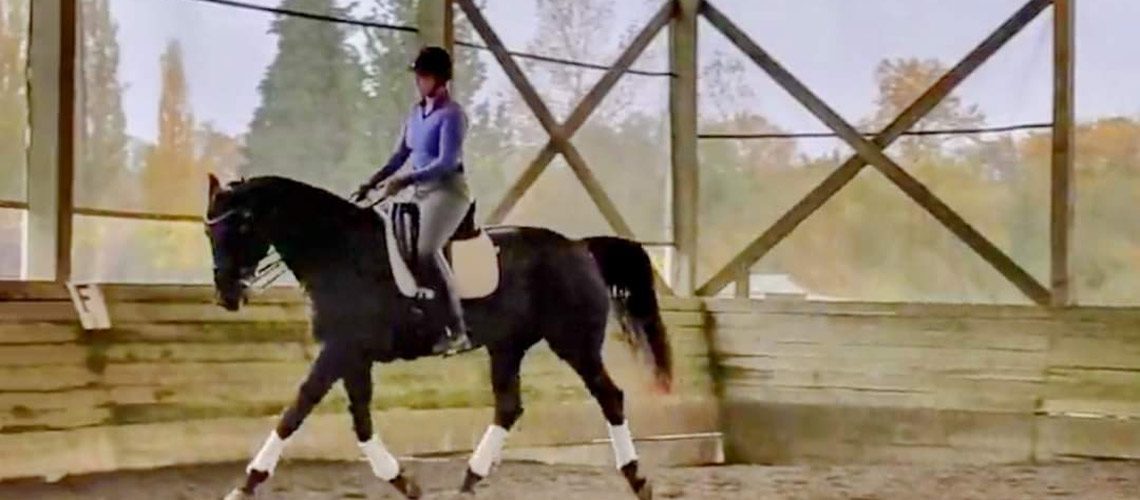Ride your horse forward and make him straight!
~ Gustav Steinbrecht
There may not be a more misunderstood concept in riding than that of “forward”. It may also be the most frequently uttered instruction in lessons across the world. It is one of the most foundational principles in training horses. Without “forward” there is no basis for rhythm, relaxation, contact, balance, straightness, or any of the building blocks of the training scale. Without forward, lateral work fizzles out, jumping distances become impossible to make, straightness is unattainable, and balance cannot be perfected.
One would think that with all the emphasis on “forward”, we would all understand exactly what it means, and how to make it happen. And yet, it seems exactly the opposite may be true, if all the lessons I’ve watched (and given) are the rule rather than the exception. If it’s such a foundational principle, then why, oh why is it so misunderstood? Why is it such a difficult thing to achieve for the average rider?
One word: Feel
The concept of forward is one that can only be *fully* understood through feel.
Let’s take a look first, at what forward is NOT. Forward is not rushing, chasing, or running. It is not unrestricted forward momentum. It is not going faster or covering more distance with each stride. It is not speed, or as one of my previous trainers used to say, it’s not Miles Per Hour. It is not the horse’s hind legs taking short steps while its front legs fling expressively out in front of it.
In every other area of our lives, forward means actual forward motion – moving from one place to another in a front-wise direction. But, that’s not what it means in riding. How confusing is that? It’s no wonder it’s misunderstood – it is like we speak an entirely different language when we speak “riding”, but the words sound the same as ones we use in our day to day language. So let’s see if we can simplify and clarify the concept of “forward” in riding.
First, I prefer to not use the word “forward” when teaching for the reason I just mentioned about language and meaning. Rather, I use words like “activity”, or “energy”. To expand on the car metaphor, it would equate to RPM (revolutions per minute) rather than MPH (miles per hour). If you rev the engine with your car in neutral, you will drastically raise the RPM while going nowhere. Similarly, the horse moves more “actively” without going faster, in order for the energy to flow through its body. In some cases, your horse does need to go more forward through space, but only in as much as it has to allow energy to flow through its body, and if it’s going too slowly, that energy isn’t flowing.
In riding, the concept of forward is a state of energy and balance that result in a horse being able to move freely through its whole body without tension or blockages to its energy, at its best capability in the moment. (In related concepts, this is also the meaning of the term “throughness” in the horse, or working “through” or “over the back”.) Achieving this requires a refined balance between the “push” and “carrying” functions of the horse’s hindquarters. Not enough “push”, and there is no flow of energy. Not enough “carrying” and there is only speed.
Another way I like to describe the concept is that the horse stays under, or “on” the rider’s seat. In other words, the horse is in front of the leg (willingly goes forward from the leg) but not in front of the rider’s balance. What does that mean? It means that the horse stays balanced under the rider’s weight such that it feels neither sluggish to respond, nor like it’s running ahead of the rider’s body. This gives the feeling to the rider as though the horse is carrying his own weight, and every movement of the rider results in an adjustment in the horse’s balance. If you’ve ever felt like you were being “run away with” at a walk, you know the feeling of the horse falling ahead of your weight and balance and not carrying its own weight.
You might begin to see how finding this balance between push and carry and freedom of movement through the horse’s body might require a well developed sense of feel from the rider, and therefore why this is such a difficult concept to really understand and master. And yet, it is *the* foundational principle required for all other training. So, how on earth is the average rider meant to find their way to forward?
There are logical steps to achieving forward with your horse.
- First, you must learn the feel on a horse that is correctly forward.
- Then you must learn to keep the feeling, because without the rider’s balance, even the most trained horse will lose its sense of forward.
- And finally, you must learn to create the feeling on your own.
Let me take a moment to be very clear and honest. If you choose to “learn with your horse” instead of learning on a trained horse first, you are setting yourself and your horse up for a great deal of frustration and discouragement. You cannot teach a horse something you don’t fully understand yourself. If you don’t know what feeling you are trying to achieve with your horse, even the best instructor in the world will struggle to teach it to you. So, make a choice now; either find an instructor with a trained horse you can learn on, or let the trainer teach your horse so that you can learn. But this is not a concept you can learn with your green horse while you are still learning to post to the trot.
Now, let’s assume your instructor/trainer is able to give you a ride on a horse – either theirs or yours – that can give you the feeling. This is the right first step, but you then have to maintain it. How do you do that? The best way is to learn the language. When you hear the words “more forward”, start automatically translating it to “more activity, but not faster”. Learn to think in terms of using your leg aids to activate the horse’s hind legs (his engine) to step more under his body, while keeping the shoulders from going faster with your weight and your reins.
This starts to stray into the area of half-halts, which I’ll write about in another blog, but suffice it to say that if you close your legs on your horse and he tightens his back and throws his head up and goes faster, you did not get “forward”. There must be a connection between the energy generated in the hind legs and the balance held by the horse’s neck and shoulders. You will never get true “forward” with loose reins, nor will you get it when your horse holds tension in his back. Tension in the horse’s back, neck, poll, or jaw restricts the full range of motion of the hind legs, which must be able to move forward freely to achieve “forward”. In reality, “forward” requires the horse’s entire body to be engaged and free from restrictions.
Again, all of this requires feel, and feeling can only be developed with time, persistence and experimentation. If there is one piece of advice I wish I could burn into the mind of every one of my students it would be to be willing to experiment and make mistakes! Don’t be afraid to fail, because those are the most valuable lessons you will ever learn.
This phase of learning the feel can happen fairly quickly, depending on how well trained the horse is that you are learning on. But, I will be very honest. The hardest part about the concept of forward is not learning the feeling of it, but learning how to create it in from the start. So, once you have the feeling, you are only halfway there.
Learning to ride well requires a tremendous amount of patience. It is a long game. It’s not easy. It’s going to take time to learn this incredibly valuable concept. But the result of really learning it and applying it in your riding will be horses that are stronger and more athletic, more comfortable in their bodies, and much easier to ride. And, a healthier, happier horse is the greatest reward.

